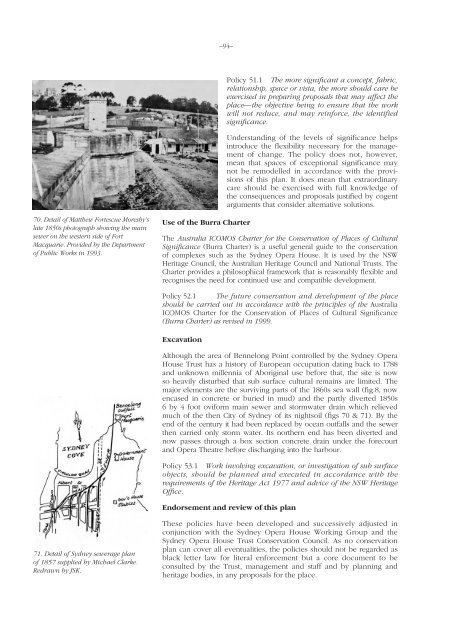Sydney Opera House conservation plan
Sydney Opera House conservation plan
Sydney Opera House conservation plan
Create successful ePaper yourself
Turn your PDF publications into a flip-book with our unique Google optimized e-Paper software.
–94–Policy 51.1 The more significant a concept, fabric,relationship, space or vista, the more should care beexercised in preparing proposals that may affect theplace—the objective being to ensure that the workwill not reduce, and may reinforce, the identifiedsignificance.Understanding of the levels of significance helpsintroduce the flexibility necessary for the managementof change. The policy does not, however,mean that spaces of exceptional significance maynot be remodelled in accordance with the provisionsof this <strong>plan</strong>. It does mean that extraordinarycare should be exercised with full knowledge ofthe consequences and proposals justified by cogentarguments that consider alternative solutions.70. Detail of Matthew Fortescue Moresby’slate 1850s photograph showing the mainsewer on the western side of FortMacquarie. Provided by the Departmentof Public Works in 1993.Use of the Burra CharterThe Australia ICOMOS Charter for the Conservation of Places of CulturalSignificance (Burra Charter) is a useful general guide to the <strong>conservation</strong>of complexes such as the <strong>Sydney</strong> <strong>Opera</strong> <strong>House</strong>. It is used by the NSWHeritage Council, the Australian Heritage Council and National Trusts. TheCharter provides a philosophical framework that is reasonably flexible andrecognises the need for continued use and compatible development.Policy 52.1 The future <strong>conservation</strong> and development of the placeshould be carried out in accordance with the principles of the AustraliaICOMOS Charter for the Conservation of Places of Cultural Significance(Burra Charter) as revised in 1999.ExcavationAlthough the area of Bennelong Point controlled by the <strong>Sydney</strong> <strong>Opera</strong><strong>House</strong> Trust has a history of European occupation dating back to 1788and unknown millennia of Aboriginal use before that, the site is nowso heavily disturbed that sub surface cultural remains are limited. Themajor elements are the surviving parts of the 1860s sea wall (fig.8, nowencased in concrete or buried in mud) and the partly diverted 1850s6 by 4 foot oviform main sewer and stormwater drain which relievedmuch of the then City of <strong>Sydney</strong> of its nightsoil (figs 70 & 71). By theend of the century it had been replaced by ocean outfalls and the sewerthen carried only storm water. Its northern end has been diverted andnow passes through a box section concrete drain under the forecourtand <strong>Opera</strong> Theatre before discharging into the harbour.Policy 53.1 Work involving excavation, or investigation of sub surfaceobjects, should be <strong>plan</strong>ned and executed in accordance with therequirements of the Heritage Act 1977 and advice of the NSW HeritageOffice.Endorsement and review of this <strong>plan</strong>71. Detail of <strong>Sydney</strong> sewerage <strong>plan</strong>of 1857 supplied by Michael Clarke.Redrawn by JSK.These policies have been developed and successively adjusted inconjunction with the <strong>Sydney</strong> <strong>Opera</strong> <strong>House</strong> Working Group and the<strong>Sydney</strong> <strong>Opera</strong> <strong>House</strong> Trust Conservation Council. As no <strong>conservation</strong><strong>plan</strong> can cover all eventualities, the policies should not be regarded asblack letter law for literal enforcement but a core document to beconsulted by the Trust, management and staff and by <strong>plan</strong>ning andheritage bodies, in any proposals for the place.
















